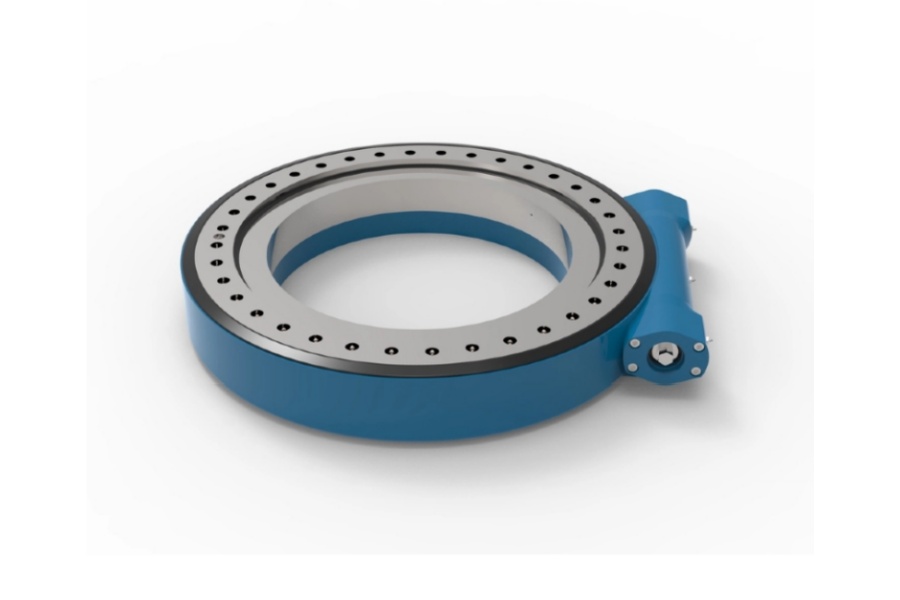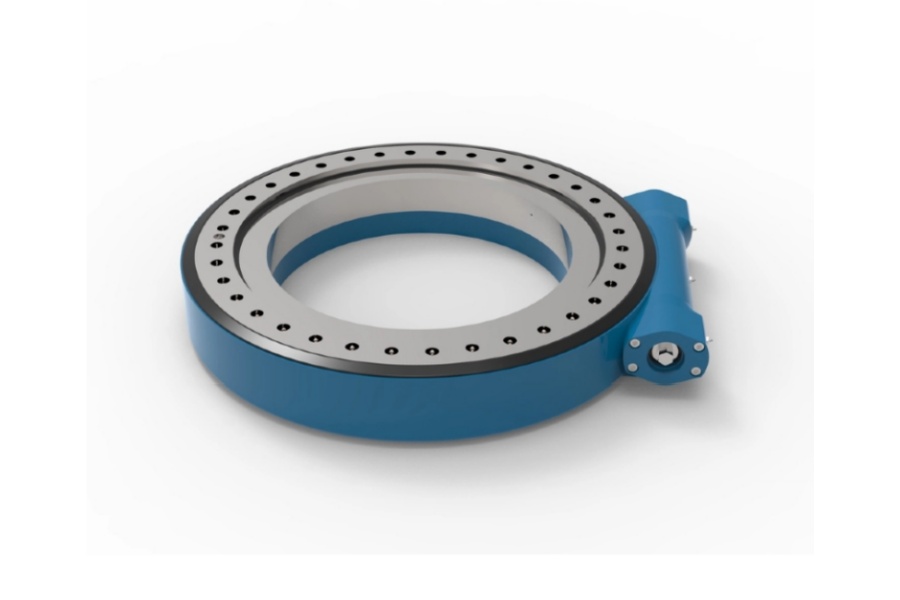
Slew Drive in Automation Equipment Applications
What is a Slew Drive
A Slew Drive is an integrated mechanical assembly that combines a slewing ring bearing with a worm gear reduction unit into a single compact package. This configuration is engineered to facilitate controlled rotational movement about a single axis while simultaneously supporting substantial combined loads. The fundamental design incorporates a worm screw that engages with a gear teeth pattern machined either internally or externally on the slewing ring. When rotational power is applied to the worm input—typically from an electric servo motor, stepper motor, or hydraulic motor—it drives the large diameter ring gear with a significant reduction ratio. This produces high output torque with precise positional control from a relatively small motor package. The integrated nature of the system allows it to handle axial, radial, and moment loads without requiring additional support structures, making it an ideal solution for space-constrained automation applications where reliability, precision, and power density are paramount requirements.

Applications in Automation Equipment
Slew drives serve as fundamental motion components across numerous automation sectors by providing precise rotational positioning under demanding load conditions. In robotic automation, these units form the core of heavy-duty robotic welding positioners, material handling turntables, and assembly station rotators that require precise angular positioning with minimal backlash. The capability to support significant off-center loads while maintaining positioning accuracy makes them indispensable for automated welding cells where large workpieces must be rotated through complex weld paths. Automated material handling systems extensively utilize slew drives in palletizing and depalletizing robots, rotary transfer stations, and automated storage and retrieval system rotators that must position loads with millimeter precision. The packaging and processing industries employ these drives in rotary filling stations, capping machines, labeling equipment, and indexing tables where continuous operation under high cycle rates demands exceptional durability. Advanced optical and inspection automation relies on high-precision slew drives with ultra-low backlash characteristics for positioning cameras, sensors, and measurement devices that require vibration-free operation and exceptional rotational accuracy. Automated assembly systems incorporate compact slew drives in rotary indexing platforms that position components for robotic assembly, testing, and packaging operations. The medical automation sector utilizes specially engineered slew drives with cleanroom-compatible materials and smooth operation for diagnostic equipment positioning, laboratory automation, and medical device manufacturing systems. Across these applications, slew drives provide the critical combination of rotational precision, load capacity, and reliability that enables advanced automation systems to maintain high throughput with minimal maintenance requirements.
Key Characteristics of Slew Drives
Slew drives possess distinctive characteristics that make them particularly valuable for automation applications. Their high torque density enables compact design solutions by delivering substantial rotational force from a small package size, allowing automation equipment designers to maximize performance while minimizing space requirements. The integrated design combines multiple functions—including bearing support, gear reduction, and often mounting structure—into a single sealed unit, reducing assembly complexity and improving system reliability. Precision positioning capability with options for low-backlash gearing makes these drives suitable for applications requiring accurate angular positioning and repeatable motion control. The inherent self-locking capability of the worm gear design provides built-in load holding without requiring additional braking systems, enhancing safety and simplifying control requirements. Robust construction allows these drives to operate in demanding environments while maintaining performance, with sealing options available for contaminated or washdown conditions common in industrial settings. Flexible configuration possibilities include various mounting orientations, drive motor interfaces, and feedback system integrations that facilitate adaptation to specific automation requirements. The high stiffness of the integrated structure ensures minimal deflection under load, maintaining precision even when handling substantial off-center loads typical in automation applications.
Broader Applications of Slew Drives
Beyond industrial automation, slew drives serve critical functions across multiple industries. The renewable energy sector employs these drives in solar tracking systems where they precisely position photovoltaic panels to follow the sun's path, significantly increasing energy generation efficiency. Construction equipment relies on slew drives for excavator upper structure rotation, crane boom positioning, and concrete pump operation where reliability under extreme loads is essential. Wind energy applications utilize these components in yaw control systems that orient nacelles into the wind and pitch control systems that adjust blade angle for power optimization. The aerospace and defense sectors incorporate precision slew drives in radar antenna positioning, satellite communication systems, and weapon station aiming mechanisms that demand exceptional accuracy and reliability. Marine and offshore applications include deck crane rotation, winch positioning, and equipment handling systems built to withstand corrosive environments. Medical equipment manufacturers use specially engineered slew drives in CT scanner gantries, surgical robot positioning, and patient table adjustment mechanisms requiring smooth, quiet operation. Transportation systems incorporate these drives in vehicle turntables, maintenance positioners, and material handling equipment that must operate with high reliability and minimal maintenance. Each industry leverages the fundamental advantages of slew drives—high torque capacity, compact design, and precise positioning—to solve unique rotational motion challenges.
Factors Influencing Slew Drive Pricing
The pricing of slew drives is determined by multiple engineering and commercial considerations. Material selection significantly impacts cost, with standard carbon steel constructions representing the most economical option while alloy steels and stainless steel versions command premium pricing for enhanced performance and corrosion resistance. Load capacity requirements directly influence price, as higher moment load ratings necessitate larger bearing diameters, more material, and more robust structural designs that increase manufacturing costs. Precision specifications such as backlash requirements, running accuracy, and smoothness of operation affect pricing through more stringent manufacturing tolerances, specialized grinding processes, and selective assembly requirements. Drive size and scale determine material volume and manufacturing complexity, with larger diameter units requiring substantially more material and specialized processing equipment. Performance features including maximum input speed, efficiency ratings, and lifetime expectations influence engineering decisions that affect final cost. Sealing and protection requirements for specific environmental conditions (such as IP ratings for moisture and dust protection or special seals for chemical resistance) add components and assembly complexity that increase price. Ancillary components such as integrated motors, brakes, feedback systems, or special lubrication systems represent additional cost factors beyond the basic drive unit. Custom engineering for unique mounting configurations, special interface requirements, or application-specific modifications requires non-recurring engineering costs that affect pricing, particularly for lower volume applications. Production volume significantly influences unit cost through manufacturing efficiencies, with high-volume OEM orders benefiting from economies of scale not available for small-batch or prototype quantities. Quality certification requirements for specific industries (such as ISO standards or military specifications) necessitate additional testing, documentation, and quality assurance processes that contribute to overall cost.
Supplier of Slew Drive
LYRADRIVE has established itself as a proficient manufacturer and global supplier of high-performance slew drives for automation and industrial applications. The company's product range encompasses both standard catalog designs and custom-engineered solutions tailored to specific automation requirements. Their technical expertise focuses on delivering drives with precise positioning capabilities, reliable operation under continuous duty cycles, and configurations that integrate seamlessly with automation systems. LYRADRIVE provides engineering support to help automation designers select optimal drive configurations for their specific load, precision, and environmental requirements. The company's manufacturing capabilities include appropriate quality control processes to ensure consistent performance characteristics essential for automation equipment. For automation engineers seeking reliable rotational motion solutions, LYRADRIVE offers technically capable products supported by appropriate application expertise.



